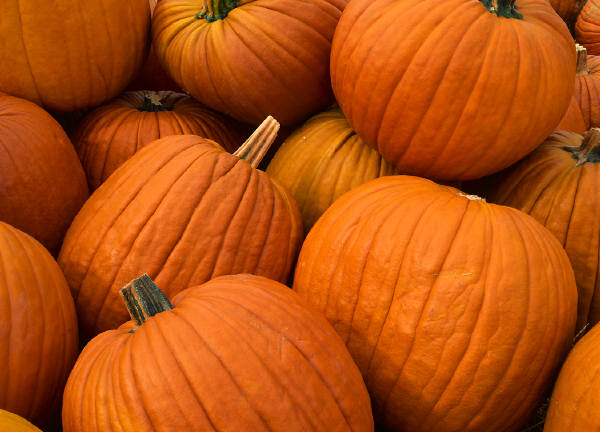
They were once recommended for removing freckles and curing snakebites. Native American Indians cut them into strips, dried them and wove them into mats. Seeds of related plants have been discovered in Mexico dating back thousands of years ago.
The Colonists coming to North America enthusiastically adopted the pumpkin grown by the Native Americans. Harvested in the fall, this large, unwieldy orange fruit (yes, it’s a fruit!) has become an icon of the Thanksgiving holiday.
“For pie filling, look for orange pumpkins identified as ‘sweet’ or ‘pie’ pumpkins,” advises Cathy Thomas, author of “Melissa’s Great Book of Produce (Wiley, $29.95). “They have thicker, sweeter flesh and are intended for cooking rather than carving.”
Thomas suggests baking whole pumpkins as a container for soups or stews. Mini-pumpkins are ideal for single servings, and would make an attractive and delicious vessel for – what else? – pumpkin soup, an aromatic starter for the Thanksgiving feast.
To bake the pumpkins, slice off the top and place them in a roasting pan. Add one inch of water and bake at 325 degrees until the flesh is tender, about 30 minutes. Before filling, leave them inverted to dry.
Now to fill these unique bowls. A new cookbook by food writers Carla Snyder and Meredith Deeds, “300 Sensational Soups” (Robert Rose) has me salivating. “Soup is not just another meal – it’s comfort in a bowl, love on a spoon, satisfaction simmering on the stove,” they write.
Pumpkin Soup with Leeks and Ginger is just the ticket for the holiday. Snyder and Deeds tested this soup using both fresh and canned pumpkin. “We couldn’t tell the difference, so we’ve called for canned for simplicity’s sake,” they note. “We love the balance of flavors: spicy ginger, subtle oniony leeks and lightly sweet and savory pumpkin.”
Or maybe you’re thinking you want to save your pumpkin for the meal’s grand finale. Steven Raichlen’s Sephardic Pumpkin Strudels end your feast with a flourish without adding fat.
Raichlen, better known as the grill guy (“The Barbecue Bible,” “How to Grill”), slashes his way through the schmaltz belt with “Healthy Jewish Cooking” (Viking), a lusciously photographed homage to his family with tasty renditions of over 150 classic Jewish recipes that nourish the soul without damaging the heart.
“I was a restaurant critic for a major city magazine in the ’80’s, eating out constantly, and developed a cholesterol problem,” recalls Raichlen, so he began reducing the fat in his favorite recipes. The result was his “High-Flavor, Low-Fat” series and “Healthy Latin Cooking,” which won a James Beard award. No Pritikin spartan, Raichlen now applies his 10 Commandments of low-fat cooking to the last bastion of the clogged artery, Jewish food, with “think flavor, not fat” his mantra.
“The great cooks of my childhood – who came of age during the depression – were more interested in filling plates than in the health consciousness of their dinners,” he writes. And with his slimmed-down versions of his family’s beloved recipes, we can have our knish and eat it too.
Reducing the fat in the Sephardic recipes – which naturally rely on greater use of grains, beans, fruits and vegetables than those of his Eastern European forebears – was less of a challenge. But where Sephardic dishes call for deep frying, Raichlen solves that problem neatly with what he does best: grilling.
Raichlen’s coiled Sephardic Pumpkin Strudels are a traditional Greek-Jewish dessert for Rosh Hashanah and Sukkot. “Their spiral shape symbolizes the cycle of life and the
ascent of the soul into heaven,” he writes.
The recipe comes from his great-aunt Lily Modiano, who began substituting canned pumpkin for calabazas (the traditional squash) when she came to America, trimming the prep time as well as the fat. Filo dough in a low-fat recipe? Sure. Use spray oil and finely chopped nuts and bread crumbs between the layers instead of butter.
For those that want to eat healthy but crave Pumpkin Pie, try Pumpkin Pie-Tinis from “The Super Food Generation: 14 Foods That Get You Glowing” by Jennifer Flynn.
Pumpkin – along with carrots, sweet potatoes and its relatives in the squash family – is one of the 14 super foods that work “synergistically with the human body to unlock vitality, strengthen immunity and literally slow down the aging process,” Flynn writes.
Excuse me? Pumpkin Pie a health food? We’re talking about a healthy Thanksgiving feast now?
Flynn created the dish one Thanksgiving when she was assigned dessert and balked at the notion of rolling out a pie crust. “I love pumpkin pie, but traditionally it is loaded with dairy, eggs and sugar, all of which have been eliminated from my diet,” she said.
And talk about presentation! “They look really cute, like mini individual trifles served in martini glasses,” she said. The creamy pumpkin mousse is sprinkled with an almond-pecan crumble, a light but satisfying end to the holiday feast.
“Pumpkin is one of the healthiest foods on the planet,” Flynn revealed. “It has the highest concentration of alpha and beta carotenes, fiber, potassium and phytonutrients known to man, as well as carotenoids, those antioxidants that lower your risk of heart disease and cancer.”
She has also presented them in little shot glasses too.” For the holidays everybody wants to eat a little of everything,” she said. “With this dessert you can indulge without over-indulging.”

Judy Bart Kancigor is the author of “Cooking Jewish: 532 Great Recipes from the Rabinowitz Family” and can be found on the web at www.cookingjewish.com.
The words of this author reflect his/her own opinions and do not necessarily represent the official position of the Orthodox Union.
